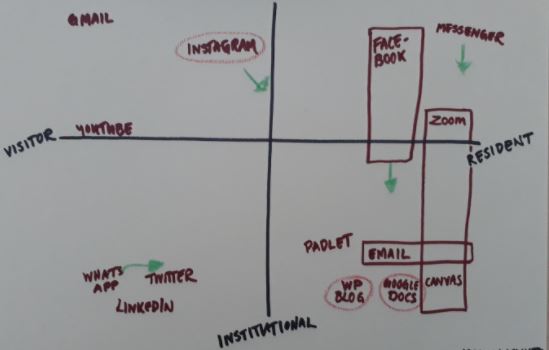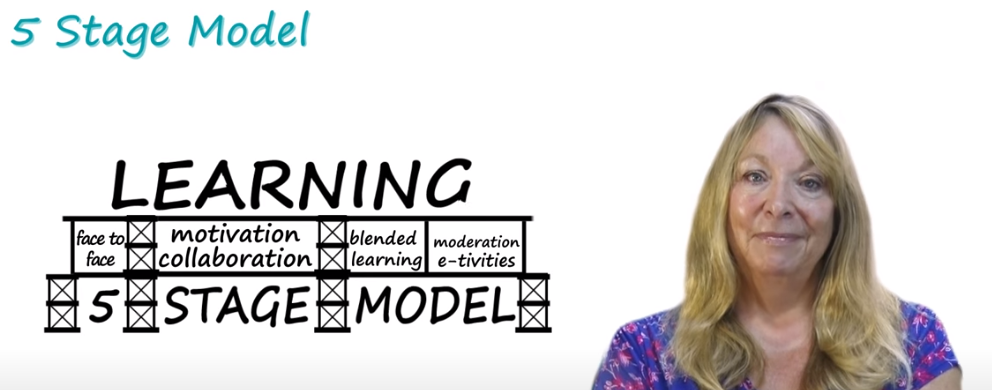Topic 1: Online participation & digital literacies
Where am I in the digital world? How do I act and where am I present? But foremost – where do I want to go and why? David White opened a box, perfectly pedagogic, for me and this is something I will bring with me to my students. I am talking about David and his Visitors and Residents mapping activity. Very important aspects of how you tend to use internet and technology which needs to be understood, both as individuals, but also as teacher/students. I found this very interesting and during his lecture he also mentioned something wise – “that there is not “best” place to be present” – “visitors” vs “residents” mode. Of course I made my own map 🙂
I perceive myself as a rather curious and digital experienced teacher , but there is so many other aspects to take into account when establishing and having an online course running. My reflections from the first weeks in the ONL-course is – starting a new course – getting to know each other – finding our roles in a group – understanding outlines and setup in the course – identifying student tasks – clarifying expectations – understanding new tools and blogging and where to find these (still not perfectly clear).

So, as an example. If involving students to go blogging, there is not like converting those who are well established in the digital world or just facebooking a lot to just swap to blogging. Regards to facebook, the students maybe tend to be residents but on a more personal level, but blogging in a course would be a mixed and stretched all between personal and professional scale on the close residential area. That is because on a blog you tend to reflect more deeply and about personal learning (at least as a student), and that might be a huge threshold for some students. Understanding HOW TO blog also needs to be included and what that means regards leaving digital traces… So including blogging as a pedagogic instrument in a course, or even better, in a program, need to be introduced step by step.
So, me and my colleagues in Public Health Sciences are starting a “distance program” this fall (Hälsa, miljö och samhälle, kandidat i folkhälsovetenskap) and we are about to establish different processes. I first need to say – I don’t like the name “distance program” because students tend to miss that this although is an education where you need to be active, present and engaged, but in an online manner. This is something I will work on during the ONL-course.
Starting a new online program is so challenging regarding many aspects, but based on my map above and the initial topic in this ONL-course I foremost continued to reflect upon how some connecting and communication ways can be used with my students (see green arrows in the map-picture). I think connecting and communicate needs to be allowed to take a bigger space in education, especially in an online education program. I found Gilly Salmons “Scaffold” model excellent, which is built upon a 5 stage model for online and blended learning. The two first stages, “Access and motivation” and “Online socialisation” needs to take place before educational aspects and learning can kick in. I will totally try to incorporate this way of thinking in our education to establish a confident and safe environment for our students. BUT – this needs to develop together with students and bring them onboard. A review article (Regmi et al, 2020) also highlighted the importance of interaction and collaboration between students and teachers, but also doing this by using user-friendly technology.

To communicate with students during a program, I just shortly want to mention some thoughts that occurred to me during my maping activities. How do we communicate with students on the best way, to reach them and make that process interactive and easy to use? There is of course Canvas and Zoom, but do students use them as we want them to? Do they use other tools like Facebook/Messenger or WhatsApp that would help communicating teacher-student and student-student? Bakker et al (2007) looked into the use of instant messaging (IM) in higher education and how we can benefit from this, and in what way. Two out of three students used IM to communicate with other students, sharing files, cooperation on school tasks and discussions with fellow students. However, only 1 % said that IM was used in teaching guidance, but 1/3 would like to see that. I am thinking that IM might be one additional way to reach students with reminders, important messages and raise questions, however there needs to be a clear limit between personal and professional area. However, once’s can always create a teacher account/profile to use for educational purposes.
References:
Bakker, G. de, Sloep, P., & Jochems, W. (2007). Students and instant messaging: a survey of current use and demands for higher education. Research in Learning Technology, 15(2). https://doi.org/10.3402/rlt.v15i2.10917
Regmi, K., Jones, L. A systematic review of the factors – enablers and barriers – affecting e-learning in health sciences education. BMC Med Educ 20, 91 (2020). https://doi.org/10.1186/s12909-020-02007-6
Salmon, G. (2016) Carpe Diem – 5 Stage Model – YouTube
White, D., Visitors & Residents – David White (daveowhite.com)
Hi! Just like you, I’ve been also wondering whether to use an additional, informal channel to communicate with my students. However, I’m worried that students would not feel comfortable with sharing their phone numbers (e.g. for WhatsApp) with me or even communicating via Messenger. In group work, when they are among themselves (so no teacher around), they often use WhatsApp to communicate. Our university does not support the use of tools other than the official ones for teacher-student communication, which is another factor. But, yes, I agree, it would be great to use something more informal than e-mails and Canvas (or Moodle – in my case).
Hi! I am planning to try out to introduce different ways of thinking and interacting t´with new students and they will be the driving force in how they want to communicate with me 🙂 Lets see how it works. Thank you for the comment!